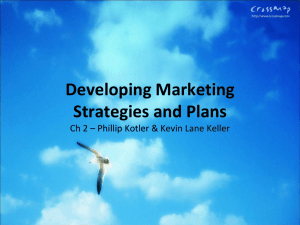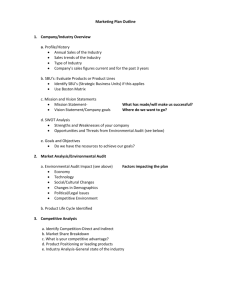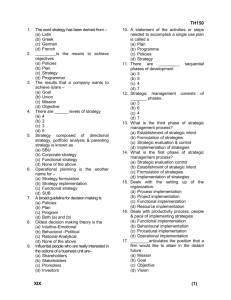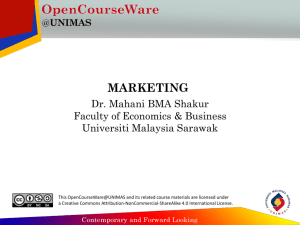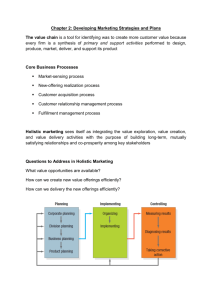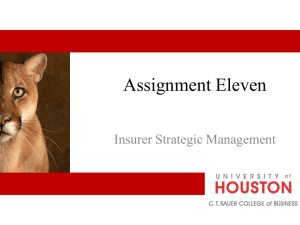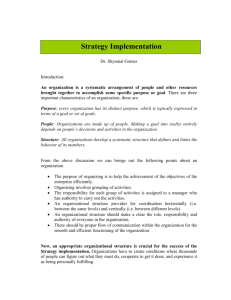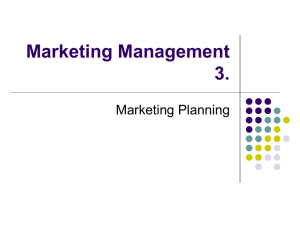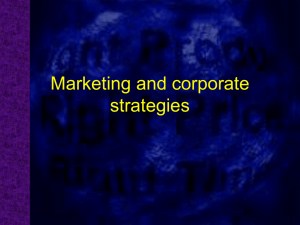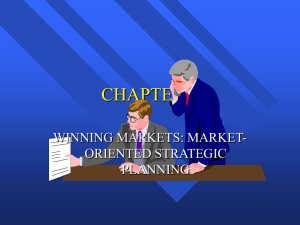(Chap2 Kotler Keller)
advertisement
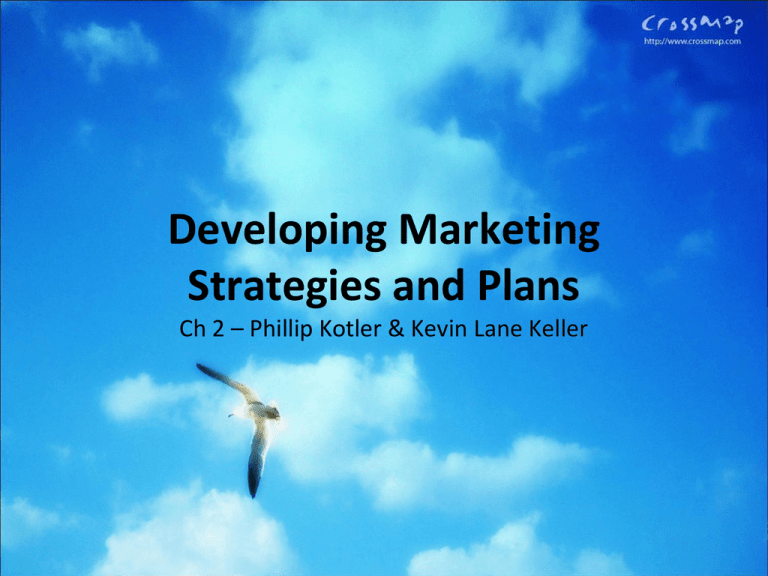
Developing Marketing Strategies and Plans Ch 2 – Phillip Kotler & Kevin Lane Keller TOPICS 1. 2. 3. 4. Marketing and Customer Values * Corporate and Division Strategic Planning * Business Unit Strategic Planning * Product Planning: the Nature and Contents of a Marketing Plan 1. Marketing and Customer Values • • • • Value delivery process Value chain Core competencies Holistic marketing orientation and customer value • Central role of strategic planning Value Delivery Process • The traditional market vs. modern market • Value creation & delivery sequence Choosing the value Providing the value Communicating the value Improving Value Delivery The Japanese Way: • Zero Customer Feedback Time (customer feedback should be collected continuously after purchase to learn how to improve the product and its marketing • Zero Product Improvement Time (the company should evaluate all improvement ideas and introduce the most valued and feasible improvements a.s.a.p.) • Zero Purchasing Time (the company should receive and required parts and supplies continuously through JIT arrangement with suppliers) • Zero Setup Time (the company should be able to manufacture any of its products soon as they are ordered, without facing high setup time or cost) • Zero Defects (the products should be of high quality and free of flaws) The Value Chain The Core Business Process • Market Sensing (all the activities involved in gathering market intelligence, disseminating it with the organization, and acting on the organization) • New Offering Realization Process (all the activities involved in researching, development and launching new high-quality offerings quickly and within budget) • Customer Acquisition (all the activities involved in defining target markets and prospecting of new customers) • Customer Relationship Management (all the activities involved in building deeper understanding, relationship and offerings to individual customers) • Fulfillment Management Process (all the activities involved in receiving and approving orders, shipping the goods on time and collecting payment) Core Competencies Core Competence: special technical and production expertise Characteristics of Core Competencies: • A source of competitive advantage • Applications in a wide variety of markets • Difficult to imitate • E.g. Southwest Airlines A Holistic Marketing Orientation And Customer Value • Value Exploration: How can a company identify a new opportunities • Value Creation: How can a company efficiently create more promising new value offering • Value Delivery: How can a company use its capabilities and infrastructure to deliver the new value offerings more efficiently Central Role Of Strategic Planning * • Successful marketing needs to: Understand customer value Create customer value Deliver customer value Capture customer value Sustain customer value • Through Marketing Plan The central instrument for directing and coordinating the marketing effort Operates in two levels (Strategic and Tactical) 2. Corporate & Division Strategic Planning Corporate Headquarters’ Planning Activities: • Define the Corporate Mission • Establish Strategic Business Unit (SBU) • Assign Resources to each SBU • Assess Growth Opportunities Defining the Corporate Mission 5 Characteristic of Good Mission Statement • Focus on a limited number • Stress major policies and values the company wants to honor • Mission statements define which competitive scopes the company will operate in: - Industry - Products and Application - Competence - Market Segment - Vertical - Geographical • Take long-term view • Short, memorable, meaningful as possible Establishing Strategic Business Unit (SBU) SBU • Single business or collection of related business that can be planned for separately • Has its own set of competitor • Has a manager who is responsible for strategic planning and profit Dimension that define Business: • Customer Group • Customer Need • Technology Assessing Growth Need • Involves in planning new business, downsizing, or terminating older business • Growth Strategies: Identify opportunity to achieve further growth with current business (marketing penetration strategy) Identify opportunity to build/acquire business that are related to current business (market-develop strategy) Identify opportunity to add attractive business unrelated to current business (diversification strategy) Backward, forward/horizontal integration Organization & Its Culture * • The success of strategic planning depends on Organization • Organization consists of: Corporate Culture Policies Structures 3. Business Unit Strategic Planning Opportunity & Threat (External) Bus. Mission SWOT ANALYSIS Strength & Weakness (Internal) Goal Form. Strat. Form. Prog. Form. Implemt. Feedback & Control SWOT ANALYSIS • External Environment Analysis (Opportunity & Threat Analysis) • Marketing Opportunity Analysis (MOA) Can the benefit be articulated to a target market? Can the target market be reached with cost-effective media and trade channels? Does the company have the critical capabilities to deliver the customer benefit? Can the company deliver these benefits better than any actual or potential competitors? Will the rate of return meet the required threshold of investment? SWOT ANALYSIS • Internal Environmental Analysis (Strength & Weakness Analysis) “is one thing to spot attractive opportunities and another to be able to take advantage of these opportunities” Goal Formulation • Goals = objective specific to magnitude and time • Trend of Mix Objectives • Set the objective & Manages by Objectives (MBO) that meet four criteria: 1. They must be arranged hierarchically 2. Objectives should be stated quantitatively whenever possible 3. Goals should be realistic 4. Objective must be consistent Strategic Formulation * Porter’s Generic Strategies • Overall Cost Leadership; eg. Acer • Differentiation; eg. Sony VAIO • Focus; eg. Apple computer for designer Strategic Alliances • • • • Product or Services; eg. HSBC & Visa Promotional; eg. Mc. D & Disney Logistic; eg. Abbott Laboratories & 3M’s medical Pricing Collaborations; eg. Hotel & car rental 4. Product Planning: Nature & Contents of a Marketing Plan Marketing Plan: a written document summarizes what the marketer has learned about marketplace indicates how the firm plans to reach its objectives Contents of the Marketing Plan 1. Executive Summary and Table of Contents 2. Situation Analysis 3. Marketing Strategy 4. Financial Projections 5. Implementation Controls END of CHAP. 2 Kotler & Ketler, 13th Ed. *
